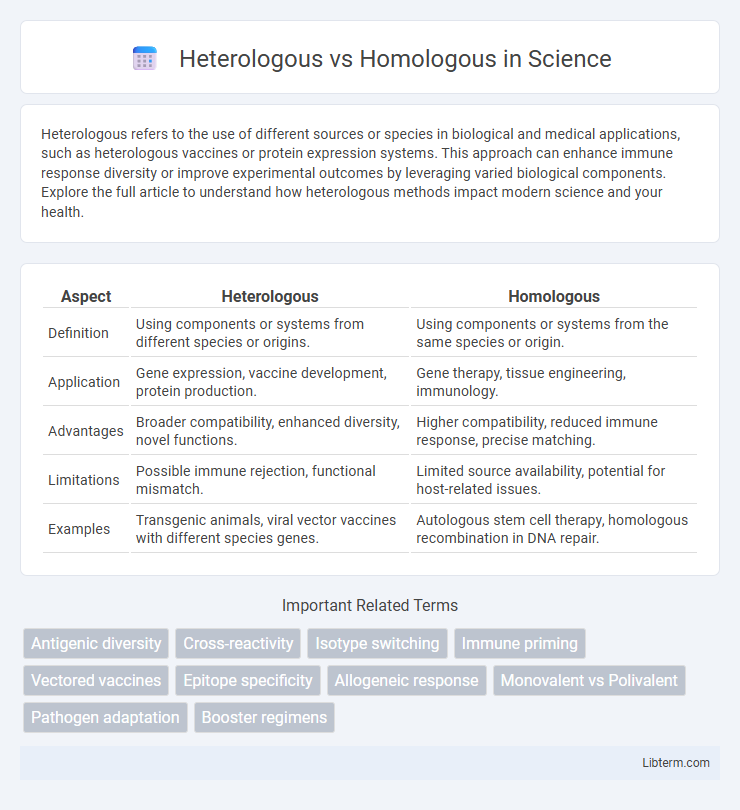Heterologous refers to the use of different sources or species in biological and medical applications, such as heterologous vaccines or protein expression systems. This approach can enhance immune response diversity or improve experimental outcomes by leveraging varied biological components. Explore the full article to understand how heterologous methods impact modern science and your health.
Table of Comparison
| Aspect | Heterologous | Homologous |
|---|---|---|
| Definition | Using components or systems from different species or origins. | Using components or systems from the same species or origin. |
| Application | Gene expression, vaccine development, protein production. | Gene therapy, tissue engineering, immunology. |
| Advantages | Broader compatibility, enhanced diversity, novel functions. | Higher compatibility, reduced immune response, precise matching. |
| Limitations | Possible immune rejection, functional mismatch. | Limited source availability, potential for host-related issues. |
| Examples | Transgenic animals, viral vector vaccines with different species genes. | Autologous stem cell therapy, homologous recombination in DNA repair. |
Introduction to Heterologous and Homologous Concepts
Heterologous and homologous concepts are fundamental in genetics and molecular biology, describing relationships between sequences or genes. Homologous sequences share a common ancestry and exhibit similar structure or function across species, while heterologous sequences originate from different sources without a shared evolutionary history. Understanding these distinctions is crucial for applications in gene therapy, protein engineering, and evolutionary studies.
Key Definitions: Heterologous vs Homologous
Heterologous refers to components or processes derived from different species or sources, often used in genetic engineering or immunology to describe mismatched elements such as vaccines or proteins introduced from one organism to another. Homologous indicates similarity due to shared ancestry or origin within the same species, commonly used to describe DNA sequences, chromosomes, or transplantation where compatibility is based on genetic identity or similarity. Understanding these distinctions is crucial in biotechnology, evolutionary biology, and medical treatments involving grafts, vaccines, and molecular cloning.
Historical Background and Evolution
Heterologous and homologous concepts trace back to early biological studies on gene transfer and immune system responses, pivotal in the development of molecular biology and immunology. Homologous approaches, involving the use of genetically similar or identical sources, have roots in classic vaccine development and tissue transplantation research from the 20th century. Heterologous methods, utilizing genetically distinct sources, evolved alongside advancements in recombinant DNA technology and cross-species immunology, driving innovations in therapeutic and vaccine design.
Applications in Medicine and Biotechnology
Heterologous expression systems enable production of proteins from one species within a different host, facilitating drug development, vaccine production, and enzyme engineering, while homologous systems involve gene manipulation within the native organism for studying gene function and metabolic pathways. In medicine, heterologous approaches support recombinant protein therapies like insulin and monoclonal antibodies, whereas homologous methods assist in gene therapy and disease modeling. Biotechnology leverages heterologous platforms for scalable biosynthesis of pharmaceuticals and biofuels, with homologous systems optimizing strain performance and genetic stability.
Advantages of Heterologous Systems
Heterologous expression systems offer significant advantages such as the ability to produce proteins in host organisms that provide higher yield, faster growth rates, and easier genetic manipulation compared to the native source. These systems enable the synthesis of proteins that are difficult or unsafe to obtain from homologous hosts, increasing research versatility and application potential in biotechnology and pharmaceutical development. Enhanced scalability and cost-effectiveness in heterologous systems support large-scale protein production for industrial and therapeutic use.
Benefits of Homologous Approaches
Homologous approaches benefit from using genetically similar or identical biological materials, enhancing compatibility and reducing immune rejection risks in therapies such as tissue engineering or transplantation. These methods promote improved integration and function, as the biological components naturally align with the recipient's cellular environment. As a result, homologous techniques often lead to more predictable outcomes and faster recovery times compared to heterologous strategies.
Comparison: Heterologous vs Homologous in Research
Heterologous systems involve expressing genes or proteins in a different species or cell type than the origin, enabling functional analysis in a controlled environment, whereas homologous systems study genes or proteins within their native organism or cell type, preserving physiological context. Research using heterologous models often provides easier manipulation and clearer functional insights, but may lack native regulatory elements, while homologous systems maintain biological relevance and endogenous interactions, crucial for studying gene function and disease mechanisms. The choice between heterologous and homologous approaches depends on the research goal, balancing experimental control with physiological accuracy.
Challenges and Limitations
Heterologous systems often face challenges such as improper protein folding, reduced stability, and limited post-translational modifications, which can hinder functional protein expression. Homologous systems, while better adapted for native protein processing, may encounter limitations including lower expression yields and difficulties in large-scale production. Both systems require optimization strategies to overcome issues like inefficient gene expression and host-specific metabolic burdens.
Case Studies and Real-World Examples
Case studies in vaccine research highlight the distinct immune responses elicited by heterologous versus homologous prime-boost strategies. For instance, real-world data from COVID-19 vaccination programs show heterologous regimens, such as AstraZeneca followed by Pfizer, produced robust antibody titers and broader cellular immunity compared to homologous schedules. Similarly, tuberculosis vaccine trials demonstrated enhanced protective efficacy when BCG was followed by recombinant protein boosts, underscoring the practical benefits of heterologous approaches across infectious diseases.
Future Perspectives and Innovations
Future perspectives in heterologous and homologous systems emphasize advancements in gene editing technologies like CRISPR-Cas9 to enhance precision and efficiency in metabolic engineering. Innovations include integrating synthetic biology with machine learning algorithms to design optimized biosynthetic pathways and improve yield in heterologous hosts. The development of robust homologous expression platforms aims to minimize off-target effects and increase the scalability of bioproduction processes in pharmaceuticals and biofuels.
Heterologous Infographic

 libterm.com
libterm.com